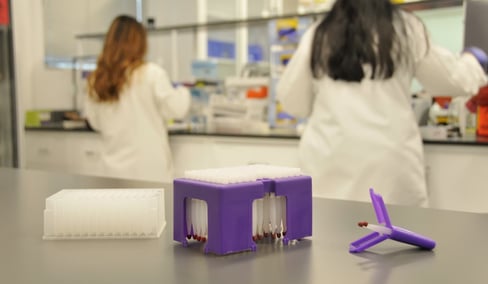Share this
Quanterix Publishes Study Paper on High-Sensitivity SARS-CoV-2 Test
by Neoteryx Microsampling on April 22,2021
At the end of March 2021, Quanterix Corporation issued a press release announcing that its Simoa® technology had been used in a research study to detect the SARS-CoV-2 virus. According to the company, Simoa uses both bead and well technology to perform a type of digital immunoassay blended with standard analogue detection for high-sensitivity quantitation across a wide concentration range.
 The SARS-CoV-2 study used serum/plasma samples, dried blood microsamples and saliva samples obtained from polymerase chain reaction (PCR)+ COVID-19 patients to test for direct antigen and also raised antibodies.
The SARS-CoV-2 study used serum/plasma samples, dried blood microsamples and saliva samples obtained from polymerase chain reaction (PCR)+ COVID-19 patients to test for direct antigen and also raised antibodies.
Mitra® devices based on VAMS® technology from Neoteryx were used for the dried blood microsampling component of the research study.
Published in Nature Communications, the research study paper is titled "N-protein presents early in blood, dried blood and saliva during asymptomatic and symptomatic SARS-CoV-2 infection." The paper illustrates that non-invasive antigen detection using blood or saliva samples, including samples collected from asymptomatic and pre-symptomatic individuals, can augment testing of nasopharyngeal (NP) swab samples.
In their news announcement, Quanterix stated that their test can detect SARS-CoV-2 viral infection during the pre-symptomatic window when transmissibility is known to be highest. Their test method can also measure viral load in blood, which can be an indicator of disease severity or progression, and potentially of therapeutic efficacy.
As quoted in the news release and related articles, Kevin Hrusovsky, Chairman, CEO and President of Quanterix and Founder of Powering Precision Health (PPH) stated, “While vaccine deployment continues at an aggressive pace, COVID-19 testing and clinical research tools will remain a global priority in the months to come." Hrusovsky added that sensitive measurements of viral antigen and the adaptive immune response from sample types suitable for remote collection could help facilitate global public health efforts to curtail viral spread while accelerating therapy development in clinical research programs.
The news announcement reiterated that current PCR-based testing remains the gold standard for COVID-19 detection, but it also stated that concerns have been raised with respect to false negative results associated with NP swabs. According to data published in the Annals of Internal Medicine, on the fifth day of infection – the median time for symptom onset and the peak of viral transmission – molecular tests show a 38% probability of producing a false result. The announcement from Quanterix also highlighted how PCR-based supply chains have been strained by increased testing demands.
The company stated that increased testing demands require additional testing options. They report that their Simoa HD-X Analyzer™ has the high-sensitivity and specificity needed to quantitate the SARS-CoV-2 nucleocapsid protein and anti-SARS-CoV-2 spike IgG directly in the various sample matrices used in their research study. Their test is reportedly authorized for use with NP swabs, but not yet authorized by the FDA for emergency use with saliva or dried blood microsamples.
According to the research team, they observed a more than 90% positive percentage agreement (PPA) of COVID-19 positive patients and a more than 98% negative percent agreement (NPA) in all matrices within seven days of a positive PCR test. They used sample cohorts that included both asymptomatic and symptomatic individuals. The research team also demonstrated an inverse correlation between nucleocapsid protein clearance and an increase in SARS-CoV-2 anti-spike IgG in all matrices. This suggests that an early and robust IgG response mitigates severe disease outcomes, even when high levels of viral nucleocapsid protein are initially present.
“With technologies like Simoa, which can measure the concentration of viral proteins in blood and saliva samples obtained non-invasively, new pathways may become available to expand access to accurate and reliable testing, and to extend our understanding of COVID-19 biology," Hrusovsky stated in the company's news release.
The results presented in the Nature Communications publication were obtained using Research Use Only (RUO) assays from Quanterix. Visit the company's COVID-19 web page for details on Simoa assays that received EUA.
This is curated content. To learn more about Quanterix’ technology, visit the Quanterix Website.
For information on using microsampling to conduct COVID-19 research, visit our infectious disease resources page or click below:

Share this
- Microsampling (41)
- Industry News, Microsampling News (35)
- Mitra® Device (34)
- Company Press Release, Product Press Release (22)
- Research, Remote Research (18)
- Infectious Disease, Vaccines, COVID-19 (15)
- Clinical Trials, Clinical Research (14)
- Biomonitoring, Health, Wellness (10)
- Blood Microsampling, Serology (10)
- Decentralized Clinical Trial (DCT) (8)
- Omics, Multi-Omics (7)
- Venipuncture Alternative (6)
- Skin Microsampling, Microbiopsy (5)
- Harpera Device (3)
- Specimen Collection (3)
- Toxicology, Doping, Drug/Alcohol Monitoring, PEth (3)
- Pharmaceuticals, Drug Development (2)
- Therapeutic Drug Monitoring, TDM (2)
- Antibodies, MAbs (1)
- Environmental Toxins, Exposures (1)
- Preclinical Research, Animal Studies (1)
- hemaPEN® Device (1)
- December 2025 (1)
- May 2025 (1)
- April 2025 (1)
- February 2025 (4)
- September 2024 (1)
- August 2024 (1)
- May 2024 (2)
- January 2024 (1)
- December 2023 (2)
- November 2023 (3)
- October 2023 (2)
- September 2023 (1)
- August 2023 (3)
- July 2023 (3)
- June 2023 (1)
- May 2023 (2)
- April 2023 (1)
- March 2023 (2)
- February 2023 (1)
- January 2023 (2)
- December 2022 (1)
- November 2022 (1)
- October 2022 (2)
- August 2022 (1)
- April 2022 (1)
- February 2022 (1)
- January 2022 (1)
- December 2021 (1)
- November 2021 (1)
- October 2021 (2)
- September 2021 (1)
- August 2021 (2)
- July 2021 (2)
- June 2021 (2)
- April 2021 (1)
- March 2021 (2)
- February 2021 (1)
- January 2021 (1)
- December 2020 (1)
- November 2020 (1)
- October 2020 (1)
- September 2020 (2)
- August 2020 (3)
- July 2020 (3)
- June 2020 (2)
- May 2020 (1)
- April 2020 (3)
- October 2019 (1)
- March 2019 (1)
- January 2019 (1)
- November 2018 (1)
- August 2018 (1)
- July 2018 (1)
- June 2017 (1)
- April 2017 (1)
- March 2017 (1)
- February 2017 (1)
- May 2016 (1)
- December 2015 (1)
- October 2015 (1)
- August 2015 (1)
- August 2014 (1)
- July 2014 (1)


No Comments Yet
Let us know what you think